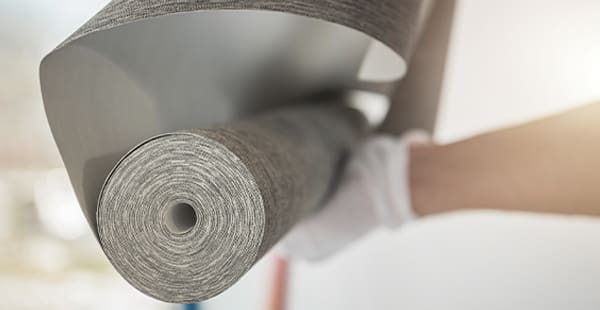01. Asbestos Use in Vinyl Products
Why Was Asbestos Used in Vinyl Products?
Vinyl is a synthetic resin or plastic material. It’s often used in flooring and wall coverings because it is cheap, durable, easy to clean and customizable. In the past, manufacturers added asbestos to vinyl floor tiles and wallpaper to improve their resistance to heat and fire.
Because of its properties, vinyl has been an ideal material for resilient flooring and wall coverings for decades. Vinyl flooring products are especially popular as inexpensive substitutes for linoleum flooring.
By the 1980s, manufacturers stopped the use of asbestos in vinyl products. Around this time, the Environmental Protection Agency (EPA) and other agencies implemented stricter asbestos regulations. Today, it’s more common to find asbestos vinyl products in older homes and buildings.
Asbestos Vinyl Products History at a Glance
- Other Names: Asbestos vinyl floor tiles, asbestos vinyl sheets, asbestos-containing wallpaper
- Years of Manufacture: 1900s – 1980s
- Places Used: Flooring, wallpaper
- Asbestos Use Banned: No
- Noteworthy Brands: Armstrong World Industries, The Flintkote Company, GAF Corporation, Kentile Floors
02. List of Asbestos Vinyl Products
List of Asbestos Vinyl Products
Prior to the 1980s, asbestos was frequently added to vinyl products. For instance, asbestos was commonly used in the following vinyl materials:
- Asbestos-containing adhesive used to install vinyl wallpaper and flooring
- Backing of vinyl sheet flooring
- Backing of vinyl wallpaper
- Vinyl asbestos floor tiles
Asbestos was used in vinyl products to enhance durability and heat resistance. Vinyl flooring contained between 10% and 25% asbestos, according to one study. Companies also made vinyl wallpaper with asbestos.
Common asbestos-containing vinyl products include:
| Product Name | Start Year | End Year |
|---|---|---|
| Armstrong Excelon Vinyl Asbestos Floor Tile | 1954 | 1980 |
| Flintkote Vinyl Asbestos Floor Tile | 1945 | 1980 |
| GAF Bright Future Luxor Vinyl Floors | ||
| GAF Fashioncraft VinylFlex Floor Tile | ||
| GAF Luran Airtred Vinyl Floors | ||
| GAF Sheet Vinyl A-1 Vinyl Floors | ||
| GAF Stoneglow Vinyl-Asbestos Floor Tile | ||
| GAF Sure-Stik Adhesive-Backed Vinyl Asbestos Tile | ||
| GAF Vinyl Asbestos Floor Tile | ||
| GAF VinylFlex Floor Tile | ||
| Kentile Floors KenFlex Vinyl Asbestos Tile | 1907 | 1986 |
| Kentile Floors Vinyl Sheet Flooring | 1907 | 1986 |
| National Gypsum Gold Bond Vinyl Topping Compound | 1964 | 1976 |
| Synkoloid Vinyl Concrete & Masonry Patch | ||
| Synkoloid Vinyl Prep Mix | 1962 | 1975 |
| Synkoloid Vinyl Tex Wall Surface Conditioner Paste | 1972 | 1976 |
Asbestos was also used in linoleum flooring. Linoleum is often confused with vinyl because of its similar appearance. Although linoleum and vinyl floors were both made with asbestos, they are two different materials. Linoleum is made from natural components, while vinyl is synthetic.
Several companies manufactured asbestos vinyl floor tiles and other vinyl products containing asbestos. Because vinyl products were popular for some time, thousands of workers and homeowners may have been exposed to these companies’ products.
Asbestos companies stopped using asbestos in vinyl products during the 1980s. Many companies already knew exposure could lead to mesothelioma and lung cancer. But they continued to use the mineral until public concern and increased regulations pressured them to stop.
03. Vinyl Products & Asbestos Exposure
Who Is at Risk of Asbestos Exposure From Vinyl Products?
Individuals who worked with asbestos-containing vinyl products are at risk of exposure. Cutting, sanding or removing these materials can release asbestos fibers into the air. Exposure to asbestos fibers can cause mesothelioma and other diseases such as asbestosis.
Commercial buildings, schools and homes built before the 1980s may contain asbestos in flooring materials or wallpaper. When asbestos products are disturbed, damaged or have deteriorated, the risk of asbestos exposure increases. This can often happen during renovations or demolitions.
Maintenance workers who work with asbestos flooring products may disturb and release asbestos fibers. This can also occur when workers use abrasive cleaning methods or products on the flooring.
Newer vinyl products in the United States no longer contain asbestos. But workers still face the risk of exposure when removing old vinyl materials. For example, construction workers who renovate or demolish buildings that contain vinyl components may be at risk.
Homeowners and employees in buildings with vinyl asbestos materials may also face exposure risks. Individuals working on DIY home renovation projects should take precautions before removing vinyl floors. Secondary exposure can also occur when someone brings asbestos fibers home on their clothing.
When someone inhales asbestos fibers, they may risk developing mesothelioma or lung cancer. Symptoms may not appear immediately. Mesothelioma can develop after a latency period of 10 – 50 years.
People who faced occupational asbestos exposure are at risk of developing mesothelioma.
Whether exposed on the job or at home, mesothelioma patients may be eligible to seek compensation.
04. Asbestos Lawsuits
Asbestos Lawsuits, Settlements & Other Compensation
People injured by asbestos products may be able to file lawsuits against manufacturers. Mesothelioma lawyers can help victims seek compensation for their injuries.
One mesothelioma lawsuit involves a carpenter who worked with asbestos floor tiles. His work included cutting and scoring the material, which released asbestos fibers. The carpenter later developed mesothelioma. He filed a lawsuit against Goodyear, the manufacturer of the vinyl floor tiles. Goodyear tried to have the case dismissed, but the judge denied the motion.
Individuals who developed mesothelioma after exposure can speak to lawyers about their options. Asbestos attorneys may be able to file lawsuits on their behalf.
Compensation Following Exposure From Asbestos Vinyl Products
Asbestos manufacturers have paid significant sums to workers and consumers. People who used their vinyl products and were later diagnosed with a related illness have received millions in compensation.
One flooring contractor developed pericardial mesothelioma after many years of working with asbestos vinyl products. He sued Congoleum and other flooring companies for compensation. When he passed away during the trial, his family joined the action with their own wrongful death lawsuit. In the end, his family and estate received nearly $3.5 million from settlements and a jury verdict against Congoleum.
Victims may also be eligible to file for compensation in other ways. Some asbestos companies have set up asbestos trust funds after declaring bankruptcy. Companies use these trust funds to compensate people injured by their products. For example, after various lawsuits like the one mentioned above, Congoleum filed for bankruptcy and set up a trust fund.
Mesothelioma lawyers can help individuals receive compensation from lawsuits, trust fund claims and other types of claims.
05. Asbestos Vinyl Products Removal
Safely Removing Asbestos Vinyl Products
Companies in the United States no longer use asbestos in new vinyl materials. But if your home has old vinyl flooring or wallpaper, it may contain asbestos. This is especially true for products installed before the 1980s.
Removing these materials can be dangerous. Damaged or aged vinyl can release hazardous asbestos fibers into the air. When asbestos can easily be crumbled into powder, it is considered friable. Friable asbestos materials pose a greater risk of exposure during removal.
Only licensed professionals should handle, remove or dispose of asbestos products. Asbestos laws and regulations provide rules and guidelines for the proper handling of asbestos.
Here’s what you can do if you suspect your home contains asbestos:
- Hire experts: Only professionals trained in asbestos abatement should handle these materials. They have the tools and knowledge to perform asbestos testing without risking harm. If necessary, they can handle asbestos removal safely.
- Check the condition: Vinyl products in good condition usually don’t release asbestos fibers. But if they’re damaged or peeling, they become a risk. At that point, professional assessment and removal might be necessary.
- Renovation tips: If the vinyl is still in good condition, you might not need to remove it. New flooring can be added on top of older flooring in some cases. However, it’s still a good idea to get an asbestos inspection before starting any work to make sure your renovation plans are safe.



